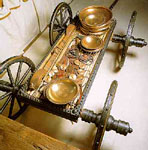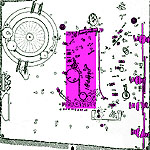Wagon
4.5 m long, box 1.71 x .68 x .085, 2.38 m long pole, 10 spokes. Bridles for 2 horses and yoke with harness (chains, leather bands) found on wagon box (Biel 1985, 95-100). Since the deceased was 1.87 m tall, he was too tall to be transported on the wagon box. The wheels had been removed and just shoved onto axles, pins were not attached and, with one nave cap, placed on the wagon box with a large set of banqueting dishes. The front axle could apparently be turned (Biel 1985, 121-128; also Pare 1987, 128-133).
The Hochdorf wagon takes up nearly half the space in the burial chamber. It was made of wood and almost completely covered with iron bands and fittings, some functional, most decorative or, at most, reinforcing. I have not found an estimate of its weight, but it must have been considerable. The wagon clearly did not transport the deceased into the tomb (see "ekphora"). The body is approx. sixteen cm longer than the wagon box. Since the chamber is cut ca. two m into the ground and lined with wood, the wagon had to be transported over the sides and placed inside the wood-clad chamber after the textiles that covered the floor had been put in place. That this was done in pieces is demonstrated by the fact that neither the horse fittings, the pole, nor the wheels were attached to the wagon box in positions suitable for driving.
The Hallstatt D practice of taking a wagon apart before placing it in the tomb is not unusual; cf. Vix, where the wheels were set against the east wall of the chamber (Egg and France-Lanord, 1987, 145. 179). There the pins and caps were placed on or under the wagon box; the pole was clearly also removed and may or may not have been included in the assemblage -- the absence of any harness or yoke material suggests that it was not (ibid. 148). The wagon box , including the fittings that suspended it above the perch, was apparently placed on the floor of the chamber and held the body of the deceased.
In the case of Hochdorf, more of the harness and wagon fittings were included in the burial; however, no attempt was made to arrange them as they would be used in life. At Vix, there would not have been room in the chamber to place the pole and wheels in position. The Hochdorf wagon fits precisely into the chamber, but neither the pole nor the wheels were reattached. The horse fittings were directly juxtaposed with the bronze dishes on the wagon box.





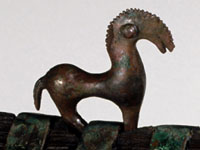
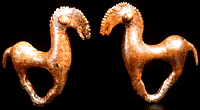
Stylistic discussion
Two groups of objects in the Hochdorf burial -- horse fittings and dishes -- have much in common. They demonstrate stylistic continuity among different classes of goods in the tomb. Both are incomplete -- they are provided for potential future use, but neither horses for the wagon nor any food matter was included in the burial. Both groups are predominantly of bronze, relatively simple in construction, and offset large unadorned areas of bronze with simple geometric ornamentation.
The set of six chains is attached to a bronze wheel-like ring ; the flat central circle is incised in concentric ribs with a coral inlay at its center.
The rims of the bronze plates are decorated with single rows of stamped motifs -- quatrefoil or cross shapes and raised concentric circles or domes predominate. The gold bowl found in the bronze cauldron is also stamped with the "Kreisaugen" or raised concentric circles motif; on the wagon, nippled half-globes or iron bosses are arranged along the top of the wagon box and in squares of nine at the corners.
The two cast bronze horses, ca. 4 cm high, that were attached by bands to the top of the yoke are exceptional. In style they approach the eloquent simplicity of the wheeled figures holding up the couch. Unlike the dotted horses on the back of the couch, their legs are brought close together in a tense, closed-bow curve echoing that of the neck, creating a compact and dynamic composition. A sawtooth mane extends up the back of the neck and down over the nose, without a break distinguishing neck and head; the muzzles are split into two pointed beaklike sections, giving the horses "smiles." Tapering tails, short and fluted, curve outward in miniature reflection of the arc of the neck. Globular protrusions to the sides near the top of the curved neck may indicate ears or eyes. In constrast to the flat, razor-blade-like shape of the necks and heads, the breast and rump portions of the horses are compactly globular; thickenings on the legs may indicate hooves. The two tiny horses are clearly close pendants, but were cast separately and from different molds.
Comparanda:

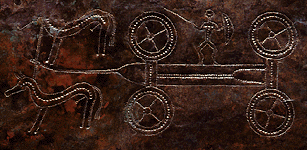

Left:Wheeled figure, Hochdorf couch
Middle: Back of Hochdorf couch
Right: Razor blade in Hochdorf tomb



Left:Wheeled figure, Hochdorf couch
Middle: Back of Hochdorf couch
Right: Razor blade in Hochdorf tomb

Left:Wheeled figure, Hochdorf couch
Middle: Back of Hochdorf couch
Right: Razor blade in Hochdorf tomb


